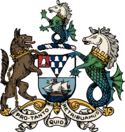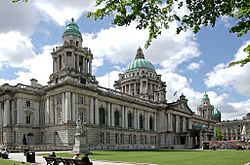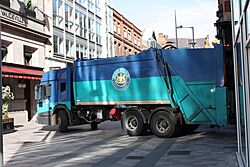Belfast City Council facts for kids
Quick facts for kids Belfast City CouncilComhairle Cathrach Bhéal Feirste Bilfawst Citie Cooncil |
|
|---|---|

Coat of arms
|
|

Council logo
|
|
| Type | |
| Type | |
| Leadership | |
|
Micky Murray, Alliance Party of Northern Ireland
|
|
|
Andrew McCormick, Democratic Unionist Party
|
|
| Structure | |
| Seats | 60 |
 |
|
| Elections | |
|
Last election
|
18 May 2023 |
|
Next election
|
2027 |
| Meeting place | |
 Belfast City Hall Belfast City Hall |
|
The Belfast City Council is the local government body for part of Belfast, the largest city in Northern Ireland. It helps manage the city and its services. The council serves a population of over 330,000 people, making it the largest district council in Northern Ireland by population. It's also the main council for the wider Belfast Metropolitan Area, which includes nearby towns and has over half a million residents.
The council is made up of 60 councillors. These councillors are chosen by voters from ten different areas within the city. They hold their meetings in the beautiful and historic Belfast City Hall. The current leader of the council is the Lord Mayor, Micky Murray, from the Alliance Party of Northern Ireland.
In 2015, the way local government worked in Northern Ireland changed. The Belfast City Council area grew to include about 53,000 more residents. Because of this, the number of councillors also increased from 51 to 60. The first elections for this larger council happened on May 22, 2014.
Contents
- Belfast City Council: A Look Back at Its History
- Belfast's Symbols: Coat of Arms and Motto
- Who Are Belfast's Councillors?
- Important Roles in the Council
- How the Council Was Reorganized in 2015
- Belfast's Representatives in Parliament and Assembly
- How the Council Works: Committees and Departments
- Belfast's Population: What the Census Shows
Belfast City Council: A Look Back at Its History
Belfast's story really began in the early 1600s. Many Protestant settlers from Scotland and England came to Ulster during a time called the Plantation of Ulster. Belfast grew into a major industrial hub, famous for making linen and building ships.
How Belfast Became a City
Because of its growth, Belfast was officially made a city in 1888. By 1901, it was the biggest city in Ireland! To show its importance, the grand Belfast City Hall was built and finished in 1906.
The Council's Modern Start
The Belfast City Council, as we know it today, was formed after local elections in May 1973. Before that, it was known as the Belfast Corporation. The city is seen as being in both County Antrim and County Down, with the River Lagan often marking the border.
Changes in Council Leadership
For a long time, the council was mostly led by unionist parties. But in 1997, this changed for the first time. No single party had full control. The Alliance Party of Northern Ireland became very important in balancing power between Irish nationalist and unionist parties. Since 1997, mayors from nationalist parties like Sinn Féin and the Social Democratic and Labour Party (SDLP), and the cross-community Alliance Party, have often been chosen.
In 2011, for the first time, Irish nationalist councillors outnumbered unionist councillors. Sinn Féin became the largest party. The 2011 census also showed a big change in the city's population. More people identified as Catholic or were raised Catholic than Protestant. Also, a significant number of people identified as British, Irish, or Northern Irish.
Belfast's Symbols: Coat of Arms and Motto
Belfast has a special Latin motto: "Pro tanto quid retribuamus." This means "For so much, what shall we give back?" It's a reminder of giving back for all the good things received.
Understanding the City's Coat of Arms
The coat of arms is like a special badge for the city. It shows a shield divided into two parts. The top part is silver and has a blue-and-white pattern that looks like fur. In the top corner, there's a red square with a silver bell. This bell might be a playful hint at the name "Belfast."
The bottom part of the shield shows a silver sailing ship on blue waves. This highlights Belfast's important history with the sea and shipping. On the sides of the shield, there's a chained wolf and a sea-horse. Above the shield, there's another sea-horse. These symbols date back to 1613 when King James I made Belfast a town. The sea-horse and ship represent Belfast's strong connection to the sea. The wolf might be a nod to Sir Arthur Chichester, who helped found the city.
Who Are Belfast's Councillors?
The most recent election for Belfast City Council was on May 18, 2023. In this election, voters chose sixty councillors to represent them.
How Many Councillors Each Party Has
The table below shows how many councillors each political party has won in recent elections:
| Party | Elected 2014 |
Elected 2019 |
Elected 2023 |
|
|---|---|---|---|---|
| Sinn Féin | 19 | 18 | 22 | |
| DUP | 13 | 15 | 14 | |
| Alliance | 8 | 10 | 11 | |
| SDLP | 7 | 6 | 5 | |
| Green (NI) | 1 | 4 | 3 | |
| People Before Profit | 1 | 3 | 1 | |
| UUP | 7 | 2 | 2 | |
| PUP | 3 | 2 | 0 | |
| TUV | 1 | 0 | 1 | |
| Independent | 0 | 0 | 1 | |
How Council Parties Have Changed Over Time
The way parties have performed in council elections has changed a lot since 1973. The Ulster Unionist Party was strong at first. Then, the Democratic Unionist Party became the main unionist party in 2005. Sinn Féin has grown to be the largest party overall.
The number of nationalist councillors has generally increased. In 2011, they became the largest group. The number of unionist councillors has mostly gone down. Parties that aim to represent all communities, like the Alliance Party, have gained more seats in recent elections.
Councillors by Electoral Area
The Belfast City Council area is divided into ten larger areas called District Electoral Areas (DEAs). Each DEA elects a certain number of councillors, usually between five and seven. This is because of the PR-STV voting system, which allows for multiple winners in one area.
Here are the ten DEAs and how many councillors they elect:
Important Roles in the Council
The Belfast City Council has several important roles, including the Lord Mayor, Deputy Lord Mayor, Aldermen, and High Sheriff.
The Lord Mayor and Deputy Lord Mayor
| Lord Mayor of Belfast | |
|---|---|

Belfast City Coat of Arms
|
|
| Style | The Right Honourable |
| Appointer | Belfast City Council |
| Term length | One year |
| Inaugural holder | Sir Daniel Dixon |
| Formation | 1892 |
| Deputy | Deputy Lord Mayor of Belfast |
The Lord Mayor of Belfast is the main leader and chairperson of the Belfast City Council. They are chosen by the council each year to serve for one year. A Deputy Lord Mayor is also usually chosen at the same time.
The Lord Mayor's job is mostly about representing the city and its people. They have several duties, such as:
- Leading council meetings and having a deciding vote if there's a tie.
- Helping to promote the council's main goals and important issues.
- Welcoming important visitors to Belfast.
- Hosting events for the city and its citizens.
- Speaking to the media about Belfast.
- Supporting charities and other good causes.
- Helping to promote Belfast's businesses, culture, and tourism.
The role of Lord Mayor started in 1613 as the 'Sovereign of Belfast'. In 1842, it became the 'Mayor of Belfast'. When Belfast became a city in 1892, the title changed to Lord Mayor. This made Belfast one of only three cities in Ireland with a Lord Mayor. In 1929, it gained the special title "the Right Honourable." Until 1973, the Lord Mayor served for three years, but now it's a one-year term.
For most of Belfast's modern history, unionist politicians held the Lord Mayor position. The first non-unionist Lord Mayor was David Cook from the Alliance Party in 1978. The first Irish nationalist Lord Mayor was Alban Maginness in 1997. A Sinn Féin Lord Mayor was first chosen in 2002. Since 1997, with no single party having a majority, the Lord Mayor position is rotated among different parties using a system called D'Hondt. This system gives positions based on how many councillors each party has.
Aldermen: An Honorary Title
The council can choose up to twelve of its members to be called Aldermen. This is an honorary title, meaning it's a special recognition, but it doesn't give them extra duties. They just get to be called "Alderman" instead of "Councillor." Aldermen are appointed after council elections.
The High Sheriff of Belfast
| High Sheriff of Belfast | |
|---|---|
|
Incumbent
Sammy Douglas (DUP) since January 2024 |
|
| Style | High Sheriff |
| Appointer | Secretary of State (on the advice of the Council) |
| Term length | One year |
| Inaugural holder | Sir James Henderson |
| Formation | 1900 |
The High Sheriff of Belfast is mostly a symbolic role today. It's like being the King's representative for justice in the city. The current High Sheriff is Sammy Douglas, who started in January 2024. While the role has few formal duties, the High Sheriff can fill in for the Lord Mayor at official events. The position was created in 1900. The Secretary of State for Northern Ireland appoints the High Sheriff each year, usually choosing someone suggested by the council.
The Lord Lieutenant of Belfast
The Lord Lieutenant of Belfast is the King's personal representative for the 'County Borough of Belfast'. This role is also mostly honorary. The current Lord Lieutenant is Dame Finnouala Jay-O'Boyle. Their few duties involve talking with the King's office before royal visits and presenting awards on behalf of the King.
How the Council Was Reorganized in 2015
Local government in Northern Ireland was changed in 2015. The councillors elected in 2011 served until March 31, 2015. Then, a new Belfast City Council was elected on May 22, 2014. This new council acted as a "shadow authority" until it officially took over on April 1, 2015.
The area managed by Belfast City Council grew on April 1, 2015. It now includes parts that used to be in the Castlereagh, Lisburn, and North Down areas. The new electoral areas for the council are Balmoral, Black Mountain, Botanic, Castle, Collin, Court, Lisnasharragh, Oldpark, Ormiston, and Titanic.
Belfast's Representatives in Parliament and Assembly
Belfast has four areas that elect representatives to both the UK Parliament and the Northern Ireland Assembly. These areas sometimes go a little beyond the city's borders.
UK Parliament Members (MPs)
In the 2019 UK general election, Belfast elected four Members of Parliament (MPs):
- Belfast North: John Finucane (Sinn Féin)
- Belfast East: Gavin Robinson (DUP)
- Belfast South: Claire Hanna (SDLP)
- Belfast West: Paul Maskey (Sinn Féin)
Northern Ireland Assembly Members (MLAs)
In the 2022 Northern Ireland Assembly election, Belfast elected a total of 20 Members of the Legislative Assembly (MLAs). Each of the four areas elected five MLAs. Before the 2017 election, each area elected six MLAs, making a total of 24 for Belfast.
The table below shows how many seats each party won in the UK Parliament and Northern Ireland Assembly elections:
| Party | UK 2019 | +/- | NIA 2022 | +/- | |
|---|---|---|---|---|---|
| Sinn Féin | 2 | 7 | |||
| Democratic Unionist Party | 1 | 5 | |||
| Social Democratic and Labour Party | 1 | 1 | |||
| Alliance Party of Northern Ireland | 0 | 5 | |||
| Ulster Unionist Party | 0 | 1 | |||
| Other | 0 | 1 | |||
How the Council Works: Committees and Departments
The Belfast City Council gets its work done through different committees and departments.
Council Committees
The council has eight committees. Councillors are chosen to be part of these committees at the council's yearly meeting. Each committee has 20 councillors. For a committee to make legal decisions, at least five members must be present. Committees usually meet every month, except for July.
The committees are set up to fairly represent the different political groups in the council. The roles of chairman and deputy chairman for these committees are given out using the D'Hondt system, which means parties get these roles based on how many councillors they have.
Here are some of the council's committees:
- Strategic Policy & Resources
- People & Communities
- City Growth & Regeneration
- Licensing Committee
- Planning
- Standards & Business
- Climate & City Resilience
- Waterfront & Ulster Hall
Council Departments
The council also has seven departments. These departments handle the day-to-day work and services for the city.
| Department | Activities |
|---|---|
| Chief Executive's | Supports the Lord Mayor and councillors in their public roles. |
| Corporate Services | Handles human resources, money matters, and computer systems. Also registers births, deaths, marriages, and civil partnerships. |
| Development | Works on community projects, culture, economic growth, events, city improvements, tourism, and managing venues like St George's Market, Ulster Hall, and Waterfront Hall. |
| Health and Environmental Services | Protects and promotes the health and safety of everyone in the city. Also manages waste, encouraging recycling and arranging for waste collection and disposal. |
| Improvement | Focuses on making the council more efficient and better at its job. |
| Legal Services | Gives legal advice to the council. |
| Parks and Leisure | Maintains the city's green spaces, organizes park events, and manages attractions like Belfast Zoo, Belfast Botanic Gardens, and Belfast Castle. |
Belfast's Population: What the Census Shows
The area covered by the current Belfast City Council has about 333,871 residents, based on the 2011 Northern Ireland census. This means it has grown since the 2001 census.
-
.
Population density
-
.
Percentage who were Catholic or brought up Catholic
-
.
Most commonly stated national identity
-
.
Percentage born outside the UK and Ireland
Key Facts from the 2011 Census
On March 27, 2011, the census collected information about the people living in the Belfast Local Government District:
- Most residents (96.77%) were white.
- About 48.82% were Catholic or raised Catholic, and 42.47% were Protestant or from other Christian groups.
- When asked about national identity, 43.32% said British, 35.10% said Irish, and 26.92% said Northern Irish. People could choose more than one identity.
The census also looked at language and education:
- About 13.45% of people aged 3 and over knew some Irish.
- About 5.23% knew some Ulster-Scots.
- About 4.34% did not have English as their first language.
For people aged 16 and over:
- 25.56% had a degree or higher qualification.
- 41.21% had no or low qualifications (like 1-4 O Levels/GCSEs).
And for those aged 16 to 74:
- 63.84% were working or looking for work.
- 52.90% had paid jobs.
- 5.59% were unemployed, and many of these had been unemployed for a long time.



